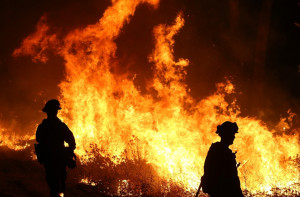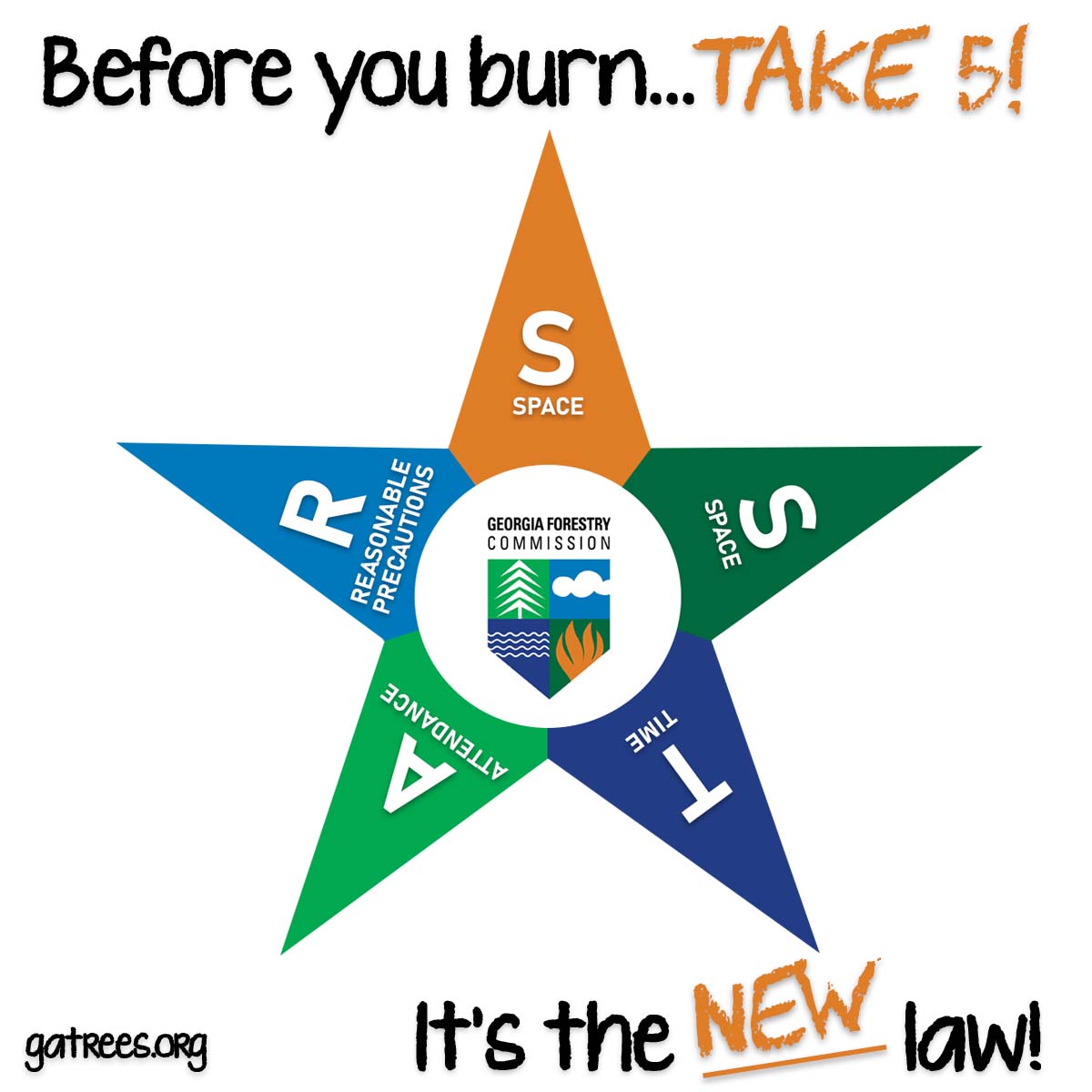* Georgia law no longer requires notification to the Georgia Forestry Commission by people planning to burn yard debris. Charges may apply if wildfire results from escaped burning and evidence show reasonable fire prevention precautions were not taken.

Fire Prevention Week is observed annually during the first full week in October (October 4-10, 2020.) It’s a good time to think about “good fire” and “bad fire,” both of which have an impact on our lives.
Prescribed fires are considered “good fires,” because they are used by knowledgeable practitioners to manage forestland for optimal health and production. “Bad fires” are wildfires and other fires that get out of control. They’re the ones we focus on during this specially designated week, because we play a major role in preventing them.
Georgia averages over 2,300 wildfires annually, with an average size of seven acres per fire. GFC personnel are prepared to respond 24 hours a day, seven days a week, 365 days a year. The Georgia Forestry Commission is responsible for all wildfire suppression in the state of Georgia.
What causes forest fires?
More than half of the wildfires in Georgia start because of careless debris burning. For this reason, most debris burning requires a burn permit. Certain weather conditions also increase the chance of fire. These include warm temperatures, wind, low humidity and atmospheric instability.
Fighting and Preventing Forest Fires
Early detection is key to effective fire suppression. When a fire emergency occurs, GFC rangers have the equipment and training needed to fight even the toughest wildfires. Landowners can help too. By implementing a Forest Management Plan and subscribing to Best Management Practices, such as prescribed burning, thinning, and firebreak installation, forest landowners can reduce the risk of wildfire and minimize impacts if fires do occur.
Fall is a critical time of year for Firewise mitigation work in our communities. Georgia’s Environmental Protection Division Summer Burn Ban ends on September 30, which means more people using outdoor burning as a tool around their homes, and increasing the wildfire ignition potential. The annual leaf change/drop adds a substantial amount of available fuels in our forests and around our homes. With cooler temperatures, we have more people enjoying the outdoors and campfires. In the fall, weather conditions become more favorable for wildfires with lower relative humidity and generally, less precipitation. Homes ignite from wildfire in one of three ways: windblown embers/firebrands, radiant heat from nearby fire, or direct flame contact. Here are the important areas to focus on around your home to help protect it from being damaged or destroyed from a nearby wildfire:
- Roof and Gutters: One of the most important things homeowners can do to protect their home from wildfire is to make certain roofs and gutters are clear of debris/fuels. Falling leaves can accumulate on roofs and in gutters, giving embers from a wildfire a rich fuel bed for ignition. NFPA Firewise Fact Sheet – Roofing.
- Decks/Porches: Similar to roofs and gutters, fuels can accumulate on or under decks and porches. It is critical to keep these areas clear of fuel accumulations. That also includes stacked firewood. It’s important to store firewood away from your home. Decks and porches are commonly constructed of wood, making them an additional fuel if exposed to direct flame contact. Anything connected to your home is part of your home, and can spread fire to your home. NFPA Firewise Fact Sheet – Decks.
- Home Ignition Zone: The space around our homes is broken into three zones. Working from the home outward, they are: the immediate zone (0-5 feet), the intermediate zone (3-30 feet), and the extended zone (30-100 feet). When beginning Firewise mitigation work at your home, start from the immediate zone and work outward. Immediate Zone: The immediate zone is the most critical for protecting against ignition from a wildfire. Clear this area of all dead plant materials. Consider using a rock mulch opposed to pine straw and tree mulch. Organic mulches give embers and flame a direct path to your home. Use plants with high moisture contents in the immediate zone and be sure to keep all dead vegetation clipped and removed for plants in this zone. Intermediate Zone: In this zone it is important to keep lawns and native grasses mowed, keep lower branches of trees trimmed to a height of six to 10 feet, and maintain fuel breaks (walkways, driveways, paths) to stop wildfire spread. Extended Zone: In this zone, focus on reducing heavy accumulations of fuels to interrupt a wildfire’s path of travel. NFPA Firewise Fact Sheet – Immediate Zone.
- Mesh Screening on Vents: Mesh screening on your home’s vents helps keep embers out. Vent screening should be 1/8 inch or smaller and be made of metal. When conditions are right for a wildfire, our homes’ attics and crawlspaces can be hot, dry, and full of fuel (cardboard boxes, clothes). These spaces can provide quick ignition if embers are able to get in. NFPA Firewise Fact Sheet – Attic and Crawl Space Vents.
- Outdoor Burning: Humans are the #1 cause of wildfire in Georgia. Fire, used in a safe and controlled manner, can be an effective and efficient tool for homeowners and landowners. Problems arise when we underestimate the potential for fire escape due to different factors, or when we overestimate our skill or comfort level. Be familiar with outdoor burning rules and regulations. If using outdoor burning as a tool around your home, stay current on weather conditions and how they can affect fire. Always obtain a permit at GaTrees.org, by calling 1-888-OK-2-BURN or your county GFC office.

